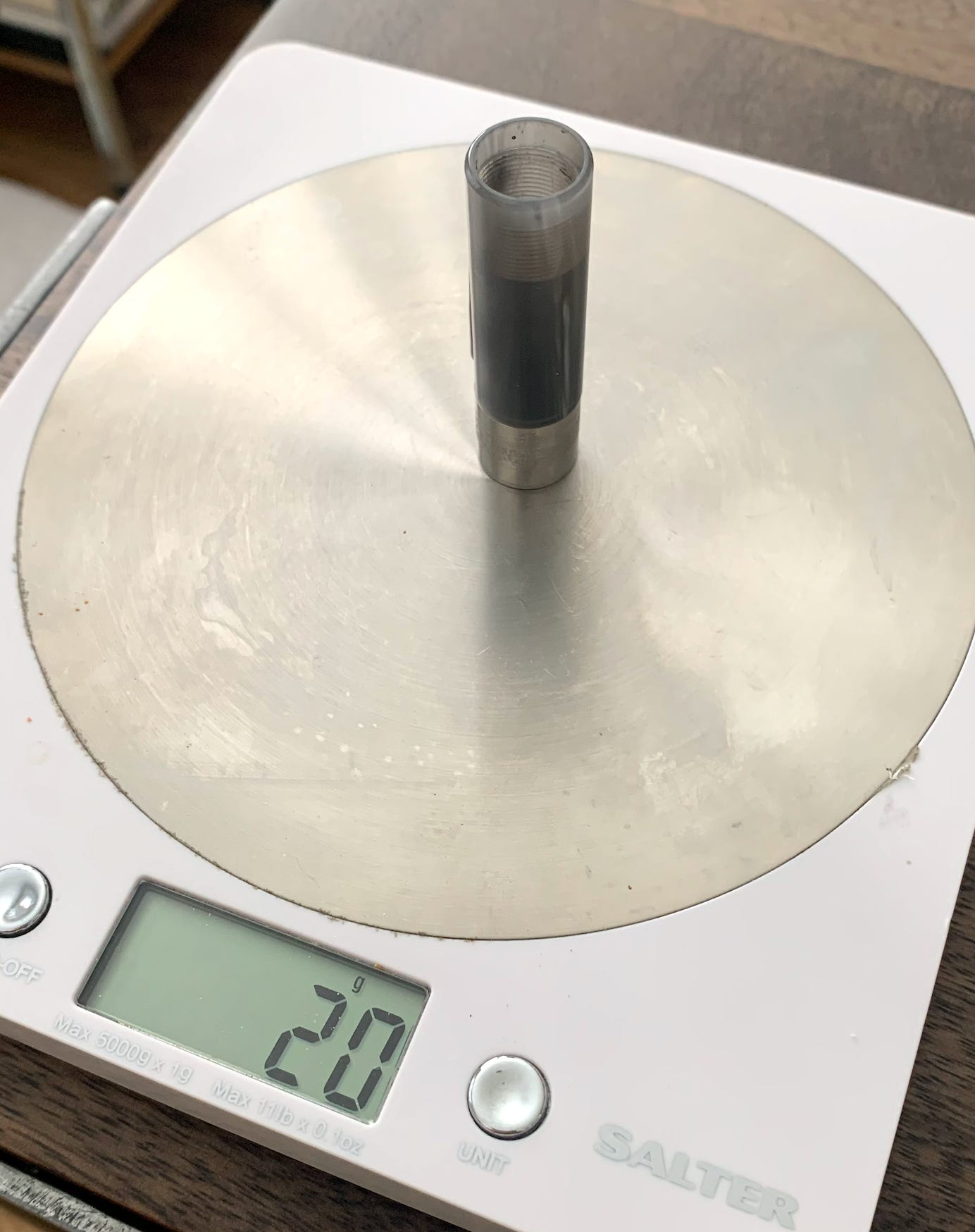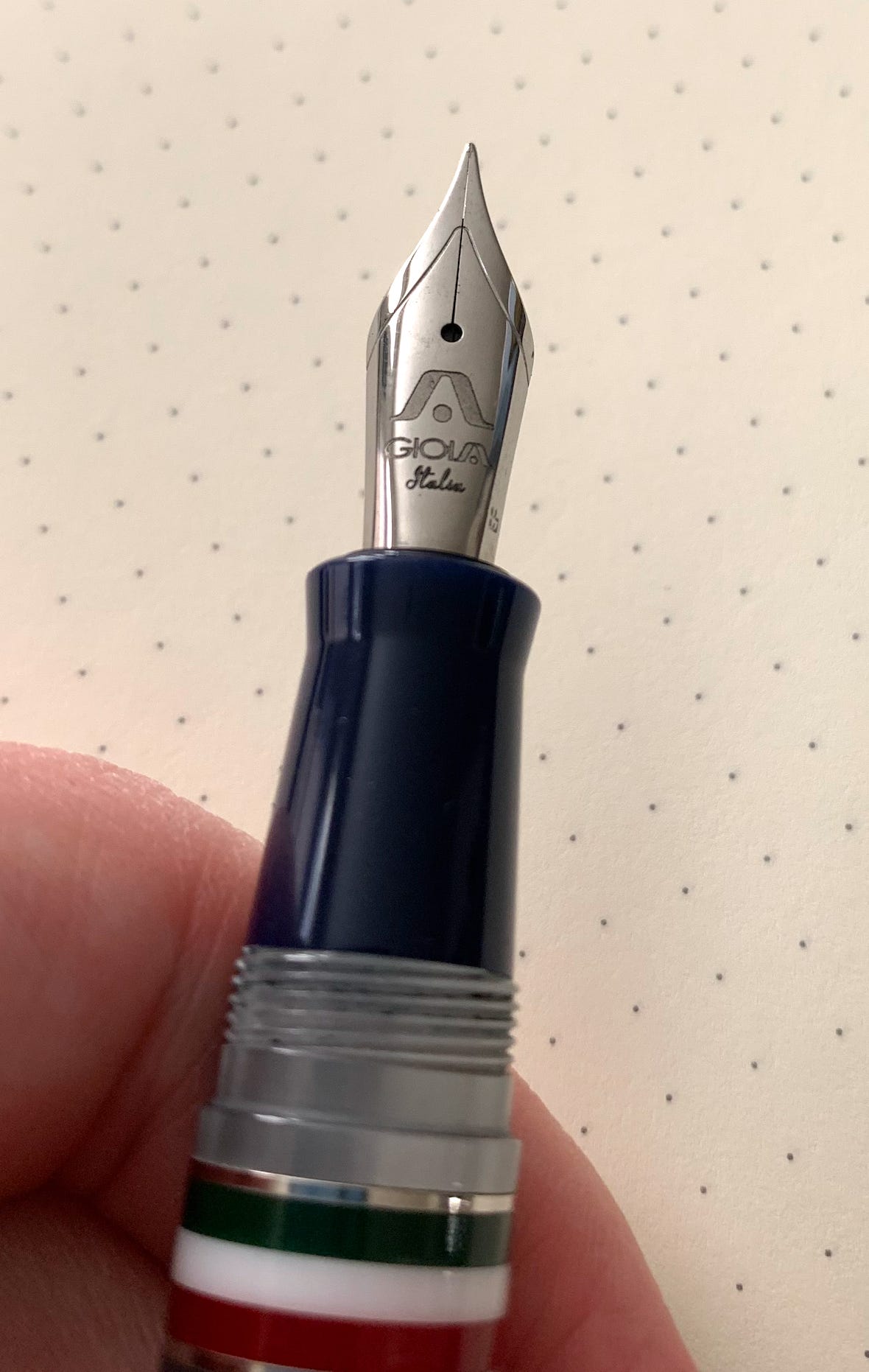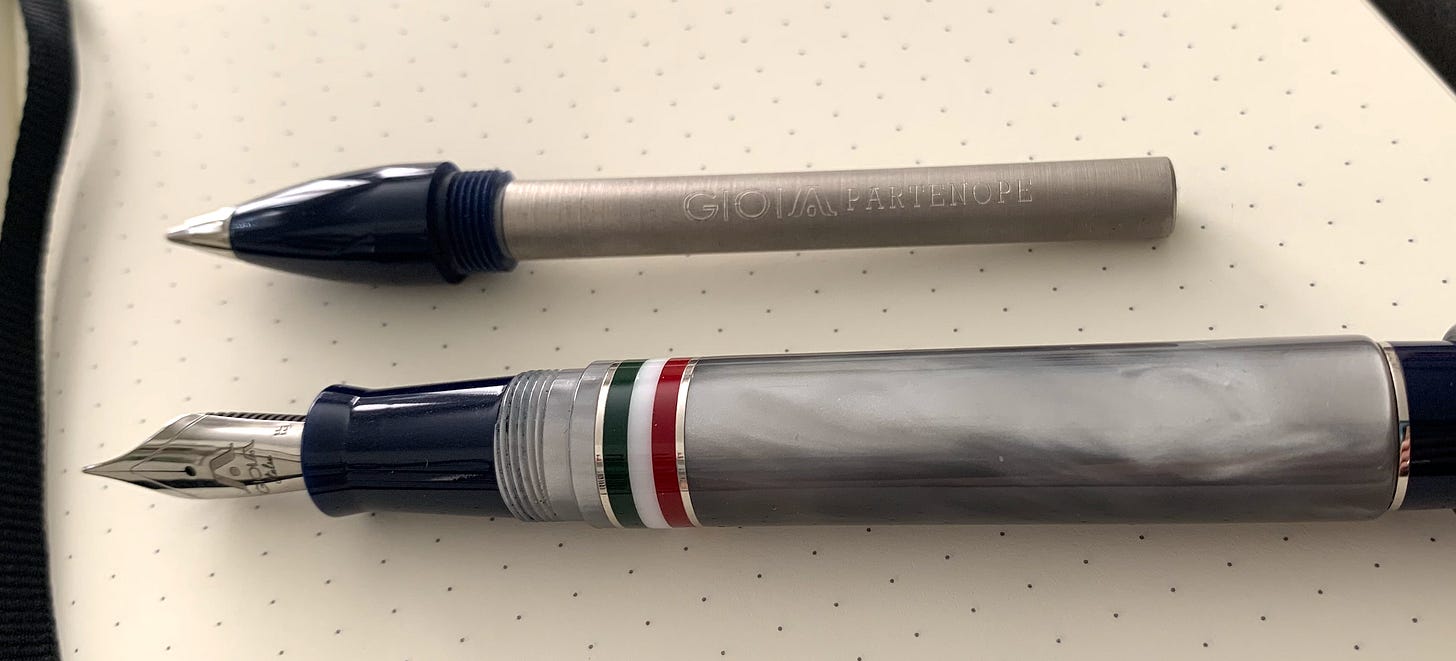This is the GIOIA Partenope.
It’s a good pen! It is also a very Italian pen.
Now, as someone who has taken Italian lessons for almost a whole year and has ridden Bell’ Italia at Ferrari World—the ride where you go through a tiny version of Italy at the world’s only indoor Ferrari-themed theme park—I think we can all agree I am the most qualified to tell you that not all pens made in Italy are “Italian pens.”
Of course, you ask: what makes a pen an “Italian pen,” as opposed to a pen simply made in Italy?
What a convenient question! Thanks so much for asking! Let’s review.
Beauty > Function
True Italian pens focus on looking rad first and being optimally useful second. You either love this or hate this.
I’m on the “love” side. To me, this is highly rational; you kind of top out on maximal pen utility after about $100 anyway, so anything beyond that is going to need to be some variation on “I like how this looks.”
And Italian pens lean into this pretty hard. While German pens will use some kind of injection-molded fiberglass composite that is also used on submarines because extensive testing showed it can survive being subjected to sub-zero temperatures and extreme pressure without cracking, Italian pen makers will be like “hey guys do you think we can make a pen out of a dinosaur pelvis.”1
In the Partenope, this tendency looks like a large metal cap finial that shows you the Gulf of Naples, which is theoretically functional because it means you won’t forget what the Gulf of Naples looks like but is probably better understood as simply a nice aesthetic choice. I mean, look how cool this looks! So nice!
On the other hand, this detail also weighs about the same as the Gulf of Naples. Like, the pen weighs 41 grams all-in:
But the cap makes up 20 grams of that.
As you might imagine, adding 20 grams to the back of a pen that otherwise weighs 21 grams will make it just a smidge back-weighted. I wouldn’t post a pen this large so this isn’t an issue for me, but still: beauty > function.
The upshot, however, is that the body itself weighs in at just 21 grams, which is only one gram heavier than the super-light Fonte Biiro (when the Biiro is posted)—so if you can use the Partenope without posting (and you probably can), it’s pleasantly light in the hand.
Copious references to Italy
A truly Italian pen will not make you wonder if it is Italian: it will scream it at you. Where a German pen might have “Germany” stamped on it in an inconspicuous place as if to conceal some deep and abiding shame, an Italian pen is going to have at least two exuberantly conspicuous references to being made in Italy.
On the Partenope, there are four. In addition to the cap showing Naples (1), the body of the pen has the tricolore of the Italian flag (2).
It also says “Italia” on the nib (3).
And the pen is called the “Partenope,” which is either a reference to a fancy pizza place in Dallas or an Italian libretto (4). Either way, that counts.
At least one feature that is cool but also arguably makes the pen worse
Finally, true Italian pens will also exhibit at least one swing-for-the-fences design choice that is awesome in concept and puzzling in practice. This is often a blind cap, which is the feature where you can unscrew the back finial of the pen to kinda sorta get at the converter. The Partenope has this.
In theory, cool. In practice, this is exactly the same amount of effort as unscrewing the barrel. It also does not work in the Partenope if, as in the above picture, you have removed the branded converter knob since the regular converter knob doesn’t stick out far enough for you to grab it.
Yes, you heard me: the Partenope comes with a branded converter knob, a detail I have seen on zero other pens.
This looks neat! But it’s metal and throws off the weight of the pen, probably explaining why I have seen it on zero other pens. In addition, it rattles against the blind cap; not a lot, mind you, just enough to be incredibly annoying.
I initially tried to fix this by jamming a tiny bit of paper towel into the blind cap to cushion it, but after that started to annoy me (because I KNEW IT WAS THERE) I decided I was going to either fix the converter or destroy it, and that’s how I learned the branded metal knob is just a sleeve you can slide right off (with some force).
Problem solved, but again: cool idea, just kinda makes things worse.
Altre cose
Functionally, the Partenope has a steel nib and it writes very well. I have an EF and it puts down one of the most saturated EF lines I have in a steel nib. The weighting and size (without the cap!) are great for my hand and I really enjoy writing with it. The grip is a comfortable grip-shaped grip, which is one area where the Italians regularly trounce German pens in terms of function.
The Partenope also comes packaged with an alternate section that turns the pen into a rollerball/ballpoint and a refill for that, which is on par with the packaging of the Tom’s Studio Pocket Pen in terms of unexpected customer delight.
Note that the refill says “GIOIA Partenope.” That’s yet another branded metal sleeve; the refill goes inside it and it screws into the section, which is how the spring that provides tension to the refill stays in place. This is a really interesting way to solve the problem without just cramming a spring into the back of the pen.
In sum: it’s a good pen! Every “criticism” I can think of relates to some bonus feature that (1) most manufacturers wouldn’t bother including in the first place and (2) can be ignored or dealt with pretty easily. It’s clear that GIOIA put a lot of love into this pen—its greatest weakness is simply that they cared too much, which is also your greatest weakness in a job interview (other than lying about your weaknesses).
My wife got the Partenope for me from Truphae last year when it went on sale because the US distributorship was ending. It is still available at Truphae, so they either got a new distributor or that sale did not work as well as they’d hoped—I’m pretty sure it’s now considerably more expensive than what she paid.
I would buy this















I might be missing something (perhaps a joke going over my head!), but I was confused by this part: "Yes, you heard me: the Partenope comes with a branded converter knob, a detail I have seen on zero other pens." — with the risk of being "that guy", I wanted to offer LAMY converters as another example of branded converter knobs.
Great article and apt description. I have the "Avorio" version of this pen (ivory/rose gold), and it's indeed ostentatious and beautiful and writes great, and it's probably due for a re-inking. I bought mine from Atlas Stationers in March 2023, and it was 50% off ($145). Perhaps that's where your wife got yours? Sadly, Atlas Stationers is out of stock. It's still a steal at the $236 Truphae is charging, though. Love this pen!